New Mexico Land of Enchantment
Rose Howard is a high-functioning autistic fifth-grader, and her preoccupation with homophones, her insistence on rules being followed to the letter of the law, and her difficulties reading social cues and understanding emotions are giving her trouble at school and frustrating her impatient and often angry single father. Rose’s own feelings of anxiety and worry are viscerally felt when her dog, Rain, gets lost after a storm wreaks havoc in her small New York town. As Rose’s sense of order is disrupted by floods, uprooted trees, and destroyed buildings, she methodically follows a plan to bring Rain home, though things don’t go as expected. Newbery Honor author Martin (A Corner of the Universe) is extremely successful in capturing Rose’s perspective and personality; Rose can’t always recognize when she is being treated unkindly (it’s no rare occurrence), but readers will see what she is up against, as well as the efforts of those who reach out to her. Filled with integrity and determination, Rose overcomes significant obstacles in order to do what is right. Ages 9–12.
Adorable! Well told!







